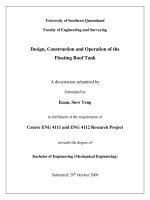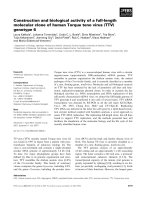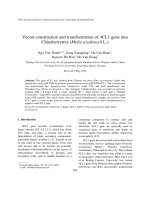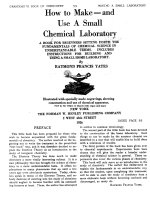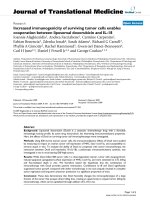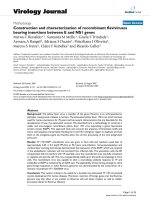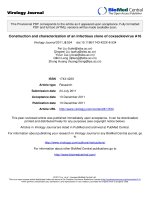Construction and immunogenicity of recombinant fowlpox vaccines coexpressing HA of AIV H5N1 and chicken IL18
Bạn đang xem bản rút gọn của tài liệu. Xem và tải ngay bản đầy đủ của tài liệu tại đây (205.31 KB, 8 trang )
Vaccine 24 (2006) 4304–4311
Construction and immunogenicity of recombinant fowlpox vaccines
coexpressing HA of AIV H5N1 and chicken IL18
Ma Mingxiao a,b,1 , Jin Ningyi a,∗ , Wang Zhenguo a , Wang Ruilin a,1 , Fei Dongliang a ,
Zheng Min a , Yin Gefen a , Li Chang a , Jia Leili a , Jin Kuoshi a , Zhang Yingjiu c
a Genetic Engineering Laboratory, Academy of Military Medical Sciences, Changchun 130062, PR China
College of Animal science and Veterinary Medicine, Jin Zhou Medical University, Jinzhou 121001, PR China
Key Laboratory for Molecular Enzymology and Engineering of Ministry of Education, Jilin University, Changchun 130023, PR China
b
c
Received 10 November 2005; received in revised form 17 February 2006; accepted 2 March 2006
Available online 29 March 2006
Abstract
cDNAs of the HA genes of subtype H5N1 AIV were fused to form a single open reading frame, designated H5HA-H7HA. The H5HAH7HA cDNA and chicken Interleukin-18 (IL18) were inserted into the fowlpox virus (FPV) expression vector pUTA-16-LacZ to produce
pUTAL-H5-H7-IL18. cDNA of H5N1 AIV HA was inserted into the FPV expression vector pUTA2 to create the recombinant expression
plasmid pUTA2-H5. Plasmids were then co-transected into CEF cells. The two recombinant fowlpox viruses (rFPV) were produced by
three cycles with the BrdU and verified by RT-PCR, IFA and Western blotting. One-day-old specific pathogen free (SPF) chickens and
7-day-old commercial Leghorn egg-laying chickens were inoculated with 106 PFU recombinant or parental fowlpox vaccine viruses by
wing-web puncture. Hemagglutination inhibition (HI) antibody titer and nonspecific cellular immunity level were assessed after 1–3 weeks
post-immunization. We found that all rFPV-vaccinated groups produced HI-specific antibodies, and the level of cellular immunity induced
by the rFPV-H5-H7-IL18 strain was significantly higher than that induced by rFPV-H5HA. At 3 weeks post-inoculation, immunized SPF
and Leghorn chickens were challenged with H5N1 HP AIV. The rFPV-H5-H7-IL18 vaccine strains were able to induce complete (10/10)
protection, while the rFPV-H5HA vaccine strain induced (9/10) protection. Cloacal swabbing samples were collected from immunized leghorn
chickens during the first week post-challenge; no shedding was found in the rFPV-H5-H7-IL18 vaccinated group. The rFPV-H5-H7-IL18
vaccinated group displayed significantly increased weight gain relative to the rFPV-H5HA group. This study reports a significant step in the
further development of new AIV vaccines.
© 2006 Elsevier Ltd. All rights reserved.
Keywords: AIV; rFPV vaccine; Immunogenicity; Hemagglutinin; IL18
1. Introduction
Avian influenza (AI) is an infectious disease caused by
avian influenza virus (AIV), which is divided into 15 hemagglutinin (HA) subtypes and 9 neuraminidase (NA) subtypes
on the basis of antigenicity of the HA and NA surface glycoproteins. Highly pathogenic avian influenza (HPAI) is caused
by particular AIV subtypes such as H5 or H7 and is classified
as a disease by the Office Internationale des Epizooties [1].
∗
1
Corresponding author. Tel.: +86 431 6985921
E-mail address: (J. Ningyi).
Authors contributed equally to this article.
0264-410X/$ – see front matter © 2006 Elsevier Ltd. All rights reserved.
doi:10.1016/j.vaccine.2006.03.006
Outbreaks of severe disease caused by influenza viruses have
been reported frequently in recent years, leading to substantial economic loss. In 1997, a highly pathogenic H5N1 AIV
strain was transmitted directly from birds to humans in Hong
Kong [2,3].
Since then H7 and H9 AIV have been identified from
humans and other mammals. These facts have made clear
that the avian influenza virus can directly cross the species
barrier and replicate in mammals, causing severe disease,
which were proved by the event AIV conveying form birds
to humans in Hong Kong [4,5]. Presently, the H5 and H7
HPAIV remain active in Southeast Asia and other parts of the
world [6,7], necessitating the development of an efficacious
M. Mingxiao et al. / Vaccine 24 (2006) 4304–4311
vaccine that can protect chickens from multiple subtypes of
lethal AIV and block spread of the virus.
It is believed that inactivated whole AIV virus vaccines
show sufficient efficacy against HPAIV, but they also induce
immune responses to the group-specific influenza A nucleoprotein (NP) antigen, which interferes with epidemiological surveillance by prohibiting direct serological distinction
between vaccinated and field-exposed birds [8]. The basis of
protective humoral immunity is the development of neutralizing antibody against HA and a variety of vaccines derived
from HA gene of AIV, including recombinant virus vaccines
[4,9,10], subunit hemagglutinin protein, and DNA vaccines
[11] that could induce subtype-specific immunity and have
shown efficacy against challenge with homologous virus are
under development.
FPV have a large double stranded DNA genome and
a host range limited to avian species [12] and have been
used to successfully express protective immunogen genes
from several viruses, including the Newcastle disease virus,
Marek’s disease virus, foot and mouth disease virus, HIV
and others. Fowlpox virus vectors for poultry, it has a great
deal of advantages, but its toxico-side effect cannot be
neglected: its inhibitory action for the increase of chicken’s
weight and immune function [5]. It has been confirmed that
some cytokines can relief its toxico-side effect. Some of the
cytokines have been proven to be effective immunomodulator in animal model or clinical test in many reports, For
example, IL1–IL8, IL12, IFN, colony-stimulating factor and
TNF, etc. as the immunomodulator, it has been demonstrated
that the cytokine adjuvant can promote the vaccines of bacterium, virus, parasite to induce protective immune response,
and enhance the vaccines effect of immunoprotection [13],
so the cytokine adjuvant is widely used lately. In 2000, the
cDNA encoding IL18 of chicken was cloned for the first
time by Schneider et al. [14], and expressed in the Bacterium
coli, it indicated that the recombinated IL18 of chicken
has the biologic activity of inducing IFN-␥ production. In
2003, Thomas et al. [15] reported that the IL18 of chicken
has a great many biologic activities, as the Th cell effective
activator, that it can induce CD4+ T cell to secrete IFN-␥
and the proliferation of T cell, in addition, it has the positive
accommodation effect for the composition of MHC ClassIIAg. In this study, we have constructed three recombinant
fowlpox viruses that coexpressing the HA genes of H5 and
H7 subtype AIV and the chicken IL18 gene or coexpressing
the HA genes of H5 subtype AIV and the chicken IL18 gene,
which was included to overcome the FPV vector-induced
inhibition and increase the efficacy of immunization.
2. Materials and methods
2.1. AIV isolated (H5N1) strain inactivated vaccine and
objective gene
Inactivated whole AIV (H5 subtype) vaccine was purchased from HaErBin, 282E4 FPV was purchased from
4305
the Department of Virology of the China Institute of
Veterinary Drug Control (TCID50 = 1 × 107 /0.1 ml). AIV
(A/Chicken/JiLin/9/2004) strain (ELD50 = 10−7.33 /0.1 ml,
LD50 =10−6.84 /0.1 ml) from chickens was isolated by
Genetic Engineering Laboratory of Academy of Military
Medical Sciences. cDNAs encoding the whole HA genes of
H5N1 subtype AIV were previously cloned and sequenced
[16]. H5N1 subtype AIV whole HA cDNA and chicken IL18
were previously cloned and sequenced [17]. A cDNA copy
of HA gene of H7N1 subtype AIV was previously manual synthesized from Biotechs Co. Ltd. (Dalian, China).
Goad anti-chicken IgG antibodies labeled by the alkaline
phosphatase, NBT/BCIP and Non-Radioactive Cytotoxicity
Assay Kit were the products of Promega (USA).
2.2. Animals
One-day-old chickens were provided by the Changchun
Academy of Agricultural Sciences and 9–10-day-old
specific-pathogen free (SPF) chickens were purchased from
Harbin Veterinary Research Institute. All experiments commenced in the under pressure isolator after the chickens had
adapted to the environmental chamber for at least 1 week. All
animal experiments were approved by the Harbin Veterinary
Research Institute.
2.3. Plasmids, vectors and chicken embryo fibroblasts
(CEF)
The fowlpox virus vector plasmid pUTAL, which was
composed of the combined promotor ATI-P7.5 (ATI promotor of cowpox virus and 20 tandemly repeated mutant
P7.5 early promotors of vaccinia virus), with LacZ gene controlled by the single promotor (16 tandemly repeated mutant
early p7.5 promotors of vaccinia virus) as a reporter gene.
282E4 strain of fowlpox virus (FPV282E4) is an attenuated vaccine produced by Animal Pharmaceutical Factory
of Nanjing (Nanjing, China). The FPV expression vectors,
pUTA-16-LacZ and pUTA2 [18,19], and recombinant plasmids encoding chicken IL18 and HA cDNA clones of H5 and
H7 AIV were used [16,17]. The CEF was produced using
method referenced Cell A Laboratory Mannual (translated
by Pei Tang Huang et al., Science Publishing Company, p.
71–8).
2.4. The homologous recombination and screening of
the recombinant virus
cDNAs encoding the whole HA genes of H5N1 subtype
AIV was cloned into vector pUTA2 under the control of ATIP7.5 × 20 promoter to produce the plasmid, pUTA2-H5. To
create the plasmids, pUTAL-H5-H7-IL18, the HA cDNAs
of subtype H5N1 and H7N1 were ligated together to form
a single opening read frame (ORF), then subcloned along
with chicken IL18 into the expression vector, pUTA-16LacZ under the respective control of the ATI-P7.5 × 20 and
4306
M. Mingxiao et al. / Vaccine 24 (2006) 4304–4311
P7.5 × 16 promoters. In the same way, the plasmid pUTALH5-IL18 was constructed. The restriction enzyme digestion,
ligation, transformation were carried out according to the
method of Sambrook et al. [20].
The recombinant fowlpox virus was prepared as described
previously [19,21,22]. Briefly, three recombinant plasmids
described above and fowlpox virus of 282E4 strain were
cotransfected to 80% confluent CEF cells via liposome.
The viruses were collected after a cytopathic effect (CPE)
appeared, and the viruses were screened under the presence of 40 g/ml BUdR for three times, and then cultured
in MEM medium without BUdR. The individual virus phage
was picked out, amplified and purified when CPE appeared.
Then the recombinant FPV were identified by RT-PCR, Western blotting.
2.5. PCR analysis of the recombinant virus
The genomic DNA of recombinant virus, extracted
by the method of SDS-Protease K-Phenol, was used as
PCR templates and amplifications were performed with
TaKaRA LA Taq polymerase applying 30 cycles of 94 ◦ C
for 1 min, 55 ◦ C for 30 s, and 72 ◦ C for 1 min. The HA
and IL18 specific primers: H5 (sense: 5 -AAAATGGAGAGAAATAGTGCTTT-3 , antisense: 5 -ACCCGGGCTACAATCTGAACTCACAAAT-3 ); H7 (sense: 5 -AAAATGAACACTCAAAT-3 , antisense: 5 -AAACTTATATACAAATGGTGCA-3 ); IL18 (sense: 5 -GAGATGGAATGCGATGCCTTTTG-3 ; antisense: 5 -TGGATCCGAGATGGAATGCGAAGCCTTTTG-3 ).
2.6. Western blotting analysis
Western blotting analysis was carried out as described previously [20]. Briefly, CEF cell layer was infected by PCR positive recombinant virus at a MOI (multiplicity of infection)
of 10 and the cells were collected when the CPE appeared.
The total cellular lysates were prepared with lysis buffer
(10 mM Tris–Cl, pH 7.4,1 mM MgCl2 , 0.5% NP40, 20 g/ml
DNase I) and electrophoresised through an SDS-12% polyacrylamide gel, and then the proteins were transferred to
nitrocellulose. Filters were probed with at a dilution of 1:500.
Bound antibody was detected by incubation of the filter
with goat anti-chicken IgG antibodies labeled by the alkaline
phosphatase at a dilution of 1:2000, followed by visualizing
with NBT and BCIP solutions (0.3% 4-nitroblue tetrazolium
chloride [NBT], 0.3% 5-bromo-4-chloro-3-indolylphosphate
[BCIP], 100 mM Tris, 100 mM NaCl, 50 mM MgCl2 ; pH
9.5).
2.7. Measurement of virus plaque forming unit (PFU)
CEF cells were infected by recombinant virus or FPV
vaccine strain at a MOI of 10, and the infected cells were
collected when 90% cytopathogenic effects appeared. After
the cell suspension was centrifuged for 10 min at 2000 × g,
the cell pellet was suspended in PBS and sonicated for
4 × 15 s, then the suspension was centrifuged for 10 min at
2000 × g, and the supernatant was collected for measurement
of virus PFU. PFU of FPV and rFPV inoculated Plaque forming units of rPFV-H5HA, rPFV-H5HA-IL18, rPFV-H5HAH7HA-IL18, and 282E4 FPV were calculated by inoculation
of 10-fold serial dilutions into CEF cells.
2.8. Immunization and challenge infection
Vaccine trials and challenge experiments in specific
pathogen free (SPF) chickens and commercial egg-laying
Leghorn chickens were conducted in BL3+ facility. All
immunizations were done by wing-web puncture with a
double needle. Approximately 50 l innoculum containing
106 PFU of FPV was administered to each chicken according to State Standard of the People’s Republic of China. All
challenge experiments were done 3 weeks after the administration of vaccine. The challenge was homologous (virus
subtype identical to that of immunizing gene).
2.8.1. Experiment 1
Fifty 1-day-old SPF chickens randomly assigned into five
groups of 10 chickens were inoculated as described above.
These groups of chickens were vaccinated with rFPV-H5HA,
wt-FPV, rFPV-H5HA-IL18, rFPV-H5HA-H7HA-IL18, inactivated vaccine respectively. Another 1-day-old SPF chickens
(n = 20) remained untreated. At 3 weeks post-vaccination,
each group was challenged with 0.1 ml of 103 ELD50 of H5
subtype HPAI virus (A/Chicken/JiLin/9/2004) by intramuscular injection into the pectoral muscle. Control chickens
were divided into two subgroups and a group was challenged.
The chickens were monitored daily for 2 weeks for survival
and clinical signs of infection, which include swollen face,
malaise, loss of appetite, diarrhoea, cyanosis of the comb or
wattles, and paralysis and death.
2.8.2. Experiment 2
Seventy 7-day-old commercial egg-laying Leghorn chickens were randomly assigned into seven groups for vaccination
and challenge. Vaccination and challenge was performed
according to the method described above. Group 7 was used
as control which was not immunized and challenged. Morbidity and survival was monitored daily to calculate the
protection ratio as described before [23]. Seven days after
challenge, cloacal swabs were collected for virus isolation
from each group.
2.9. Serology
HA and hemagglutinin inhibition (HI) assays were performed with 0.5 chicken red blood cells as previously
described [24]. Sera from chickens were tested individually
after treatment with receptor-destroying enzyme. HI titers
were determined as the reciprocal of the highest serum dilution that completely inhited hemagglutination. (Diagnostic
M. Mingxiao et al. / Vaccine 24 (2006) 4304–4311
4307
Fig. 1. Schematic representation of fowlpox virus expression vector (pUTA2, pUTAIL) and recombinant plasmid (pUTA2-H5N1), pUTAIL-H5-IL18, pUTAILH5-H7-IL18.
techniques for highly pathogenic avian influenza. State Standard of the People’s Republic of China: GB/T 18936-2003.)
2.10. Comparison of spleen lymphocytes proliferation
and the effect of rFPV on the body weight
Fifty 1-day-old commercial Leghorn chickens were randomly assigned into five groups for comparison of spleen
lymphocyte proliferation. Seven days after breeding, chickens were immunized as above with rFPV-H5HA, rFPVH5HA-IL18, wt-FPV, rFPV-H5HA-H7HA-IL18 or PBS as
a control.
To investigate the effect of rFPV on body weight, 100 oneday-old SPF chickens were immunized in the same manner.
At 1 and 2 weeks after immunization, all SPF chickens were
weighed.
2.11. Statistical analysis
Differences between groups were analyzed by Student’s ttest. Results were expressed as the mean ± standard deviation
(S.D.). P values less than 0.05 were considered statistically
significant in all cases.
3. Results
3.1. Construction and identification of the recombinant
plasmids
To prepare recombinant fowlpox viruses expressing
H5N1, coexpressing H5N1 and IL18, coexpressing H5N1,
H7N1and IL18, and three recombinant plasmids were constructed (Fig. 1). The fowlpox virus expression vector pUTA2
under the control of ATI-P7.5 × 20 promoter to produce the
plasmid pUTA2-H5. The fowlpox virus expression vector
pUTAL was flanked with TK gene and contained two kinds of
promotors whose directions were opposite and reporter gene
LacZ. The reporter gene LacZ, which located on the downstream of the single promotor P7.5, was replaced with IL18
gene, and HA genes were inserted into the downstream of the
combined promotor ATI-P7.5. The restriction endonuclease
digestion pattern showed that the two genes were inserted
correctly into the vector (data not shown).
3.2. Screening of recombinant virus by PCR analysis
To detect whether the interest genes were inserted successfully into the genome of fowlpox virus via homologous
recombination, the genome of the recombinant fowlpox virus
was extracted as the template and PCR was performed with
three pares of specific primers. Three specific DNA bands of
1.7 kb were amplified for positive recombinant virus, whereas
there was no specific DNA band was detected for negative
virus (data not shown).
3.3. Biological characteristics of HA protein expressed
by rFPV-H5, rFPV-H5-IL18 and rFPV-H5-H7-IL18
identified by Western blot
AIV HA proteins expressed by rFPV-H5, rFPV-H5-IL18
and rFPV-H5-H7-IL18 were revealed by Western blot analysis (Fig. 2). The PCR positive recombinant virus was inoculated into CEF cell, and the infected cells were collected and
4308
M. Mingxiao et al. / Vaccine 24 (2006) 4304–4311
Fig. 3. Splenocyte lymphocytes proliferation stimulated by Con A.
Fig. 2. Detection of expressed protein by Western blot assay: (1) prestained
protein marker (broad range); (2) H5HA expressed by rFPV-H5HA-IL18;
(3) H5HA expressed by rFPV-H5HA; (4) H5H7HA expressed by rFPVH5HA-H7HA-IL18.
the cellular lysates were prepared after CPE appeared. The
lysates were sampled into SDS-PAGE and transferred into
nitrocellulose membrane. The proteins were probed by antiH5N1 antibodies and goat anti-chicken antibody conjugated
with alkaline phosphatase sequentially and visualized with
NBT/BCIP. The results showed that the recombinant virus
expressed the foreign proteins in infected CEF cells, Two
bands with molecular weights of 56 kDa and one band with
molecular weights of 112 kDa were detected, demonstrating
that HA from AIV H5 and H7 subtype were expressed in CEF
cells (Fig. 3).
3.4. Protection induced by immunization with
rFPV-H5HA-H7HA-IL18, rFPV-H5HA-IL18 and
rFPV-H5HA
Chickens immunized with rFPV-H5HA-H7HA-IL18,
rFPV-H5HA-IL18 and rFPV-H5HA were challenged with
0.1 ml isolated H5N1 AIV. Morbidity, mortality, and reduced
viral shedding were detected 2 days after infection with an
otherwise lethal dose of virus. SPF chickens immunized with
106 PFU rFPV-H5HA-H7HA-IL18 and rFPV-H5HA-IL18
were completely protected (10/10). None of these chickens
presented clinical signs of AIV infection or died after challenge with H5 subtype HPAIV; whereas, 9 out of 10 of the
SPF chickens immunized with the inactivated whole AIV
(H5 subtype) vaccine or rFPV-H5HA were protected. Similarly, commercial Leghorn egg laying chickens immunized
with 106 PFU rFPV-H5HA-IL18 and rFPV-H5HA-H7HAIL18 were also 100% (10/10) protected, while were 9/10 were
protected when immunized with inactivated whole AIV (H5
subtype) vaccine and rFPV-H5HA. In contrast to the vaccine
groups, control chickens injected with wt-FPV or PBS did
show clinical signs by the third day of infection and died
within a week after challenge. Furthermore, we were unable
to isolate virus from chickens immunized with rFPV-H5HAH7HA-IL18 and rFPV-H5HA-IL18 1 week post-challenge,
while virus was discovered in one chicken immunized with
rFPV-H5HA. All surviving chickens of the control groups
were found to shed challenge viruses in the cloaca. These
results demonstrate that immunization with rFPV-H5HAH7HA-IL18, rFPV-H5HA-IL18 and rFPV-H5HA is able to
protect chickens from lethal challenge with H5 subtype of
HPAI viruses.
Seven days following challenge, AIV was isolated and
propagated in the allantoic cavities of 11-day-old embryonated chicken eggs. The isolated viruses were characterized
Table 1
Protection of recombinant vaccine for SPF chicken against challenge
Groups
Dose of inoculation
Vaccining age
(days)/challenging age (days)
Ratios of chicken shedding
virus 7 days post-challenging
rFPV-H5HA-IL18
rFPV-H5HA-H7HA-IL18
rFPV-H5HA
Inactivated vaccine
wt-FPV
Negative control
106 PFU
106 PFU
106 PFU
0.2 ml
106 PFU
0.2 ml PBS
7/28
7/28
7/28
7/28
7/28
7/28
0/10
0/10
1/10
1/9
–
–
Negative control all died.
Table 2
HI antibodies of H5 subtype AIV induced by rFPV for SPF chicken/commercial egg laying chicken
7 days
14 days
21 days
rFPV-H5HA-IL18
rFPV-H5HA-H7HA-IL18
rFPV-H5HA
Inactivated vaccine
wt-FPV
Negative control
2.15 ± 0.32/3.22 ± 0.42
3.26 ± 1.02/4.56 ± 1.52
3.21 ± 1.21/4.33 ± 1.22
202 ± 0.16/252 ± 0.51
3.04 ± 0.92/3.94 ± 0.32
3.01 ± 0.88/3.64 ± 0.82
3.14 ± 0.17/3.62 ± 0.12
4.04+0.91/4.04 ± 0.71
4.56 ± 0.37/4.45 ± 0.53
3.98 ± 0.26/3.93 ± 0.12
5.94 ± 0.51/5.53 ± 0.61
7.85 ± 0.83/7.45 ± 0.63
0
0
0
0
0
0
M. Mingxiao et al. / Vaccine 24 (2006) 4304–4311
4309
Table 3
HI antibodies of H7 subtype AIV induced by rFPV for SPF chicken/commercial egg laying chicken
rFPV-H5HA-IL18
7 days
14 days
21 days
rFPV-H5HA-H7HA-IL18
wt-FPV
Negative control
2.10 ± 0.15/2.43 ± 0.49
2.90 ± 0.62/3.5 ± 0.56
3.05 ± 0.88/3.58 ± 0.9
0
0
0
0
0
0
Note: antibody titers denote significant difference at 7 and 14 days old (P < 0.05); dose of inoculation, 106 PFU.
by hemagglutination inhibition assays with subtype-specific
antisera against HA (Table 1). These results demonstrated
that the rFPV described here, especially rFPV-H5HA-H7HAIL18 and rFPV-H5HA-IL18, which was more effective than
rFPV-H5HA, can remarkably reduce the release of AIV.
3.5. Antibody responses of chicken’s immunizated with
rFPV
We examined the relative capacities of HA-rFPV vaccines
to induce serum antibodies. Serum samples from chickens of
all groups were collected for analysis of the anti-HA antibody
levels by HI (Tables 2 and 3). Although SPF chickens immunized with rFPV-H5HA-H7HA-IL18, rFPV-H5HA-IL18 and
rFPV-H5HA were positive for HA antibody after 1 week,
the level was very lower. However, the HI antibody titers
increased by 2–3 weeks after immunization. A similar change
was observed in immunized commercial Leghorn chicken.
3.6. Comparison of spleen lymphocyte proliferation and
the effect of rFPV on body weight
Two weeks after vaccination, splenocytes were collected
from commercial Leghorn chickens and stimulated with
concanavalin A (Con A) free of pathogenic microorganisms. As shown in Fig. 3, proliferation of lymphocytes from
the rFPV-H5HA-H7HA-IL18 and rFPV-H5HA-IL18 immunized chickens were significantly higher than that of chickens
immunized with rFPV-H5HA or wt-FPV (P < 0.05). We suggest that expression of IL18 by rFPV-H5HA-H7HA-IL18
and rFPV-H5HA-IL18 is responsible for this effect and may
enhance immunization with FPV.
Immunized SPF chickens were weighed every week after
immunization (Table 4). Chickens vaccinated with rFPVH5HA-H7HA-IL18, rFPV-H5HA-IL18 or unvaccinated controls had higher body weights than chickens vaccinated with
rFPV-H5HA or wt-FPV, suggesting that IL18 can reduce the
effects of the FPV vector on chicken body weight.
4. Discussion
When some H5 and H7 AIV detected in infected poultry, control measures are frequently instituted to prevent the
spread of virus due to the potential for a virulence shift
resulting in a serious disease outbreak [25]. Conventional
inactivated vaccines have been considered to be effective for
the control and prevention of avian influenza outbreaks, but
the host response, antibodies against the vaccine NP antibody, prevents distinction between vaccinated and field-virus
exposed birds. A more advanced approach may be to use a
recombinant vaccine that avoids the above caveat. Fowlpox
viruses are a member of the avipoxvirus genus of the family
poxviridae and possess many of the desirable characteristics of vaccinia virus [26]. Fowlpox viruses undergo abortive
replication in nonavian cells and cannot be adapted to produce
infective progeny virus in mammalian tissue. They readily
infect mammalian cells in vitro and induce synthesis of foreign gene products, which are displayed on the cell membrane
in the case of viral surface glycoproteins [27,28]. Despite
their inability to replicate in these hosts, recombinant fowlpox
virus vaccines have induced protective immune responses
to inserted foreign genes products in several mammalian
species. The lower level of antigen production from fowlpox
virus vaccines compared to vaccinia virus may preferentially
stimulate T-cell rather than antibody responses. Furthermore,
antigenic competition from immune responses to vector antigens is likely to be lower for the weakly replicating fowlpox
virus than for vaccinia virus. And fowlpox viruses only propagate strictly in the cytoplasm, which avoids the possibility of
the integration of FPV genome into the host’s chromosome,
they are safer as vaccine vectors. Therefore, fowlpox viruses
are used not only as a live vector vaccine for avian disease,
but also as an ideal vector for mammals and humans [29].
HA is the major protective antigen of AIV and HA antibodies against it constitute the primary defense against virus
infection. Thus it is an appropriate gene to produce genetically engineered vaccine. The protective effect of various
Table 4
The effects of rFPV on the body weight gain of 1-day-old SPF chickens
Groups
Dose of inoculation
Body weight (g) 7 days post-inoculation
rFPV-H5HA-IL18
rFPV-H5HA-H7HA-IL18
rFPV-H5HA
wt-FPV
Challenged control
106
65.1
64.9
62.3
61.8
68.6
PFU
106 PFU
106 PFU
106 PFU
02 ml PBS
Note: letters a–d denote significant difference (P < 0.05).
±
±
±
±
±
5.3a
5.6a
7.3b
7.3b
8.4a
Body weight (g) 14 days post-inoculation
115.5
114.2
101.8
99.8
120.5
±
±
±
±
±
11.4c
11.8c
13.5d
13.5d
18.1c
4310
M. Mingxiao et al. / Vaccine 24 (2006) 4304–4311
kinds of vaccines targeting HA protein has been established
in previous studies, but this immunity is limited to the
specific homologous HA subtype [30]. When compared to
conventional vaccines, these recombinant vaccines have the
advantage of not interfering with epidemiologic surveillance
studies, which detect antibodies against NP, to monitor natural infection. In addition, immunization with recombinant NP,
or NP expressed by pox vectors induces only partial protection against challenge infection with homologous influenza
virus [31,32]. In the current study, chickens inoculated with
the rFPV expressing fused HA genes of H5 and H7 AIV
and chicken IL18 were protected from intramuscular challenge with H5 AIV. Neither viral replication nor clinical signs
of infection were observed in these chickens. Meanwhile,
chickens inoculated with rFPV expressing only HA from H5
AIV were also protected from H5 AIV challenge, but some
chickens did become infected and local viral replication was
observed. Furthermore, rFPV-H5-H7-IL18 and rFPV-H5HAIL18 vaccinated groups displayed significant body weight
gain compared to groups vaccinated with rFPV-H5HA. At 3
weeks post-inoculation, immunized SPF and Leghorn chickens were challenged with H5N1 HPAIV. rFPV-H5-H7-IL18
and rFPV-H5- IL18 vaccine strains were able to induce complete (10/10) protection against an otherwise lethal challenge
with HPAIV, while the rFPV-H5HA vaccine strain induced
90% (9/10) protection.
We found that all rFPV-vaccinated groups produced HIspecific antibodies, and the level of cellular immunity induced
by the rFPV-H5-H7-IL18 and rFPV-H5-IL18 strain was significantly higher than that induced by rFPV-H5HA. The
rFPV-H5-H7-IL18 and rFPV-H5- IL18 vaccinated group displayed significantly increased weight gain relative to the
rFPV-H5HA group. Through comparison of spleen lymphocyte proliferation and the effect of rFPV on body weight, it
showed indirectly that the IL18 can increasing the immunogenicity of vaccine just as other study showing [33,34].
Although the H7 challenge experiment was not conducted,
the HI-specific antibodies from H7HA viruses were significant which shown in Table 3. The protective efficiency exhibited by rFPV-H5-H7-IL18 suggests that it can be a valuable
candidate vaccine for the control of H5 AIV and may be for
the control of H7 AIV. The effectiveness of this vaccine in
actual field application remains to be determined in the future.
Acknowledgements
This work was supported by a grant from the China
Department of Science and Technology (CDST) and Jilin
Provincial Department of Science and Technology (JDST).
References
[1] Alexander DJ. A review of avian influenza in different bird species.
Vet Microbiol 2000;74:3–13.
[2] Subbarao K, Klimov A, Katz J, Regnery H, Lim W, Hall H, et al.
Characterization of an avian influenza A (H5N1) virus isolated from
a child with a fatal respiratory illness. Science 1998;279:393–6.
[3] Claas EC, de Jong JC, van Beek R, Rimmelzwaan GF, Osterhaus
AD. Links Human influenza virus A/Hong Kong/156/97 (H5N1)
infection. Vaccine 1998;16:977–88.
[4] Hunt LA, Brown DW, Robinson HL, Naeve CW, Webster RG.
Retrovirus-expressed hemagglutinin protects against lethal influenza
virus infections. J Virol 1988;62:3014–9.
[5] Leong KH, Ramsay AJ, Boyle DB, Ramshaw IA. Selective induction of immune response by cytokines coexpressed in recombinant
fowlbox virus. J Virol 1994;68:8125–30.
[6] Spackman E, Senne DA, Davison S, Suarez DL. Sequence analysis
of recent H7 avian influenza viruses associated with three different outbreaks in commercial poultry in the United States. J Virol
2003;77:13399–402.
[7] Fouchier RAM, Schneeberger PM, Rozendaal FW, Broekman JM,
Kemink SAG, Munster V, et al. Avian influenza A virus (H7N7)
associated with human conjunctivitis and a fatal case of acute respiratory distress syndrome. PNAS 2004;101:1356–61.
[8] Beard CW, Schnitzlein W, Mand Tripathy DN. Protection of chickens
against highly pathogenic avian influenza virus (H5N2) by recombinant fowlpox viruses. Avian Diseases 1991;35:356–9.
[9] Chamber T, Kauaoka Y, Webster RG. Protection of chickens from
lethal influenza infection by vaacinia expressed hemagglutinin. Virology 1988;167:414–21.
[10] Webster RG, Kawaoka Y, Taylor J, Weinberg R, Paoletti E. Efficacy
of nucleoprotein and haemagglutinin antigens expressed in fowlpox
virus as vaccine for influenza in chickens. Vaccine 1991;9:303–8.
[11] Kodihalli S, Sivanandan V, Nagaraja KV, Shaw D, Halvorson DA.
A type-specific avian influenza virus subunit vaccine for turkeys:
induction of protective immunity to challenge infection. Vaccine
1994;12:1467–72.
[12] Bolte AL, Meurer J, Kaleta EF. Review: avian host spectrum of
avipoxviruses. Avian Pathol 1999;28:415–32.
[13] Noll A, Autenrieth IB. Immummunity against Yersinia enterocolitica by vaccination with Yersinia HSP60 plus interleukin-12. Infect
Immun 1996;64:2955–61.
[14] Schneider K, Puehler F, Baeuerle D, Elvers S, Staeheli P, Kaspers
B, et al. cDNA cloning of biologically active chicken interleukin-18.
J Interf Cytokine Res 2000;20:879–83.
[15] Thomas WG, Kirsten S, Beatrice S. IL-18 stimulates the proliferation and IFN-␥ release of CD4+ T cells in the chicken: conservation of a Th1-like system in a nonmammalian species. J Immunol
2003;171:1809–15.
[16] Wang ZG, Jin NY, Ma MX, Jin KS, Zhang HY, Yin GF. Cloning
and analysis of molecular evolution of hemagglutinin gene of avian
influenza virus subtype H5 N1. Chin J Biol 2004;17:358–60.
[17] Wang ZG, Jin NY, Ma MX, Zhang HY, Yin GF, Jin KS. Cloning
and expression of chicken mature IL218 gene in E. coli. Chin J Biol
2004;17:84–6.
[18] Gu WJ, Jin NY, Yin Z. Sequence analysis TK gene in 2.2 kb fragment of fowolpox virus 282E4 genome. Ann Anthol Univ Agri Anim
Sci PLA 1995:1–6.
[19] Jin NY, Guo ZR, Luo K, Shi Y, Yin Z. Sequence analysis of a
7.3 kb BamHI genomic fragment of folpox virus strain 282E4. Chin
Sci Bull 1999;44:2068–72.
[20] Sambrook J, Fritsch EF, Maniatis T. Molecular cloning: a laboratory manual. 2nd ed. Cold Spring Harbor, NY: Cold Spring Harbor
Laboratory Press; 1989. p. 33–48.
[21] Jin NY, Zhang HY, Yin GF, Zheng M, Liu T, Jiang WZ, et al.
Immunogenicity of recombinant fowl-pox virus co-expressing structural protein precursor P1-2A and proteinase 3C of FMDV. Chin Sci
Bull 2004;49:823–7.
[22] Xia ZP, Jin NY, Jin KS, Guo ZR, Xu LF, Wang H, et al. Immunogenicity and antigenicity of recombinan fowlpox viruses coexpression of NDV F and IBDV VP0 gene. Chin J Vet Sci 2003;23:214–7.
M. Mingxiao et al. / Vaccine 24 (2006) 4304–4311
[23] Alexander DJ, Gough RE. Isolations of avian influenza virus from
birds in Great Britain. Bet Rec 1986;118:537–8.
[24] Lu X, Cho D, Hall H, Rowe T, Sung H, Kim W, et al. Pathogenicity
and antigenicity of a new influenza a (H5N1) virus isolated from
duck meat. J Med Virol 2003;69:553–9.
[25] Villareal CL, Flores AO. The Mexican avian influenza (H5N2) outbreak. In: Proceedings of the fourth international symposium on
avian influenza. Richmond, Virginia: US Animal Health Association; 1998. p. 18–22.
[26] Baxby D, Paoletti E. Potential use of non-replicating vectors as
recombinant vaccines. Vaccine 1992;10:8–9.
[27] Taylor J, Paoletti E. Fowlpox virus as a vector in non-avian species.
Vaccine 1988;6:466–8.
[28] Taylor J, Weinberg R, Languet B, Desmettre P, Paoletti E. Recombinant fowlpox virus inducing protective immunity in nonavian
species. Vaccine 1988;6:497–500.
[29] Jiang W, Jin N, Cui S, Li Z, Zhang L, Zhang H, et al. Construction
and characterization of recombinant fowlpox virus coexpressing HIV1 (CN) gp120 and IL-2. J Virol Meth 2005;130:95–101.
4311
[30] Johansson BE, Matthews JT, Kilbourne ED. Supplementation of
conventional influenza A vaccine with purified viral neraminidase
results in a balance and broadened immune response. Vaccine
1998;16:1009–15.
[31] Tite JP, Hughes-Jenkins C, O’Callaghan D, Dougan G, Russell SM,
Gao XM, et al. Anti-viral immunity induced by recombinant nucleoprotein of influenza A virus. II. Protection from influenza infection
and mechanism of protection. Immunology 1990;71:202–7.
[32] Webster RG, Kawaoka Y, Taylor J, Weinberg R, Paoletti E. Efficacy
of nucleoprotein and haemagglutinin antigens expressed in fowlpox
virus as vaccine for influenza in chickens. Vaccine 1991;9:303–8.
[33] Jiang WZ, Jin NY, Li ZJ, Zhang LS, Han WY. Construction of
recombinant fowlpox virus coexpressing gp120 of Chinese HIV1 strain and IL-18 and its immunogenicity in mice. Chin J Biol
2004;20:337–41.
[34] Degen WG, van Zuilekom HI, Scholtes NC, van Daal N, Schijns
VE. Potentiation of humoral immune responses to vaccine antigens by recombinant chicken IL-18 (rChIL-18). Vaccine 2005;23:
4212–8.
